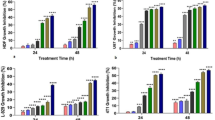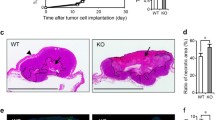Abstract
Endothelium plays a vital role in the logistics of the immune system, as well as the maintenance of the homeostasis. The major objective of this study is to unravel the relationship between expression changes of carbohydrate structures and the dysfunction of human umbilical vein endothelial cells (HUVEC) stimulated with tumor-conditioned medium (TCM), which is involved in tumor cell extravasation. Using flow cytometry (FCM) assay, the expression profiles of a selected group of 9 carbohydrate structures have been determined in HUVEC under control conditions and TCM-treated conditions, six of which increased significantly in expression after induction. Particularly, the expression level of β-1,6-GlcNAc branching glycan was extremely higher after the stimulation. In parallel, the conformation change of HUVEC monolayer has been detected with inverted phase contrast microscopy and confocal microscopy. Under TCM stimulation, the actin cytoskeleton underwent rearrangement and formed abundant stress fiber within cells; therefore cell contraction was induced, which resulted in paracellular gap formation and barrier dysfunction. We furthered our study to investigate the mechanism underlying the conformation change of HUVEC. The results demonstrated that TCM induced the increase in β-1,6-GlcNAc branching expression of PECAM-1, accompanied by the tyrosine phosphorylation of PECAM-1. The downstream effector RhoA was activated in consequence of the activation of PECAM-1. In conclusion, our results strongly suggested that the carbohydrate composition of endothelial cell surface is very important for the cells to exert their physiological effects correlated with cancer extravasation.







Similar content being viewed by others
Abbreviations
- HUVEC:
-
Human umbilical vein endothelial cells
- TCM:
-
Tumor-conditioned medium
- FBS:
-
Fetal bovine serum
- FITC:
-
Fluorescein isothyocianate
- SDS-PAGE:
-
Sodium dodecyl sulfate polyacrylamide gel electrophoresis
- mAb:
-
Monoclonal antibody
- pAb:
-
Polyclonal antibody
- HRP:
-
Horseradish peroxidase
- ECGS:
-
Endothelial cell growth supplement
- PBS:
-
Phosphate-buffered saline
- BSA:
-
Bovine serum albumin
- TBS:
-
Tris-buffered saline
- Fn:
-
Fibronectin
- GnT-V:
-
N-acetylglucosaminyltransferase V
- MTT:
-
3-[4,5-Dimethylthiazol-2-yl]-2,5-diphenyltetrazoliun bromide
References
Dube DH, Bertozzi CR (2005) Glycans in cancer and inflammation—potential for therapeutics and diagnostics. Nat Rev Drug Discov 4:477–488
Zhao Y, Li J, Wang J, Xing Y, Geng M (2007) Role of cell surface oligosaccharides of mouse mammary tumor cell lines in cancer metastasis. Indian J Biochem Biophys 44:145–151
Guo HB, Lee I, Kamar M, Pierce M (2003) N-acetylglucosaminyltransferase V expression levels regulate cadherin-associated homotypic cell-cell adhesion and intracellular signaling pathways. J Biol Chem 278:52412–52424
Liwosz A, Lei T, Kukuruzinska MA (2006) N-glycosylation affects the molecular organization and stability of E-cadherin junctions. J Biol Chem 281:23138–23149
Yang J, Mani SA, Donaher JL, Ramaswamy S, Itzykson RA, Come C, Savagner P, Gitelman I, Richardson A, Weinberg RA (2004) Twist, a master regulator of morphogenesis, plays an essential role in tumor metastasis. Cell 117:927–939
Garcia-Vallejo JJ, Van Dijk W, Van Het Hof B et al (2006) Activation of human endothelial cells by tumor necrosis factor-α results in profound changes in the expression of glycosylation-related genes. J Cell Physiol 206:203–210
Luster AD, Alon R, Andrian UH (2005) Immune cell migration in inflammation: present and future therapeutic targets. Nature Immunol 6:1182–1190
Dull RO, Dinavahi R, Schwartz L et al (2003) Lung endothelial heparan sulfates mediate cationic peptideinduced barrier dysfunction: a new role for the glycocalyx. Am J Physiol Lung Cell Mol Physiol 285:986–995
Miao BC, Li J, Fu XY et al (2005) Sulfated polymannuroguluronate, a novel anti-AIDS drug candidate, inhibits T cell apoptosis by combating oxidative damage of mitochondria. Mol Pharmacol 68:1716–1727
Bruewer M, Hopkins AM, Hobert ME et al (2004) RhoA, Rac1, and Cdc42 exert distinct effects on epithelial barrier via selective structural and biochemical modulation of junctional proteins and F-actin. Am J Physiol Cell Physiol 287:327–335
Damiani D, Michieli M, Michelutti A et al (2004) Antibody binding capacity for evaluation of MDR-related proteins in acute promyelocytic leukemia: onset versus relapse expression. Clin Cytom 59:40–45
Dejana E, Corada M, Lampugnani MG (1995) Endothelial cell-to-cell junctions. FASEB J 9:910–918
Rival Y, Del Maschio A, Rabiet MJ et al (1996) Inhibition of platelet endothelial cell adhesion molecule-1 synthesis and leukocyte transmigration in endothelial cells by the combined action of TNF-α and IFN-γ. J Immunol 157:1233–1241
Waschke J, Curry FE, Adamson RH, Drenckhahn D (2005) Regulation of actin dynamics is critical for endothelial barrier functions. Am J Physiol Heart Circ Physiol 288:1296–1305
Su WH, Chen HN, Jen CH (2002) Differential movements of VE-cadherin and PECAM-1 during transmigration of polymorphonuclear leukocytes through human umbilical vein endothelium. Blood 100:3597–3603
Lu TT, Yan LG, Madri JA (1996) Integrin engagement mediates tyrosine dephosphorylation on platelet-endothelial cell adhesion molecule 1. Proc Natl Acad Sci USA 93:11808–11813
Newton JP, Hunter AP, Simmons DL et al (1999) CD31 (PECAM-1) exists as a dimer and is heavily N-glycosylated. Biochem Biophys Res Commun 261:283–291
Tapon N, Hall A (1997) Rho, Rac, and Cdc42 GTPases regulate the organization of the actin cytoskeleton. Curr Opin Cell Biol 9:86–92
Gratzinger D, Canosa S, Engelhardt B, Madri JA (2003) Platelet endothelial cell adhesion molecule-1 modulates endothelial cell motility through the small G-protein Rho. FASEB J 17:1458–1469
Folkman J, Haudenschild C, Zetter BR (1979) Long-term culture of capillary endothelial cells. Proc Natl Acad Sci USA 76:5217–5221
Papetti M, Herman IM (2002) Mechanisms of normal and tumor-derived angiogenesis. Am J Physiol Cell Physiol 282:947–970
Utoguchi N, Mizuguchi H, Saeki K et al (1995) Tumor-conditioned medium increases macromolecular permeability of endothelial cell monolayer. Cancer Lett 89:7–14
Castilla MA, Neria F, Renedo G et al (2004) Tumor-induced endothelial cell activation: role of vascular endothelial growth factor. Am J Physiol Cell Physiol 286:1170–1176
Cook-Mills JM, Deem TL (2005) Active participation of endothelial cells in inflammation. J Leukoc Biol 77:487–495
O’Brien CD, Lim P, Sun J, Albelda SM (2003) PECAM-1-dependent neutrophil transmigration is independent of monolayer PECAM-1 signaling or localization. Blood 101:2816–2825
Acknowledgment
This research was supported by the National Basic Research Program Grant (973) (2003CB716400).
Author information
Authors and Affiliations
Corresponding authors
Rights and permissions
About this article
Cite this article
Peng, Y., Li, J. & Geng, M. The glycan profile of endothelial cells in the present of tumor-conditioned medium and potential roles of β-1,6-GlcNAc branching on HUVEC conformation. Mol Cell Biochem 340, 143–152 (2010). https://doi.org/10.1007/s11010-010-0411-z
Received:
Accepted:
Published:
Issue Date:
DOI: https://doi.org/10.1007/s11010-010-0411-z




